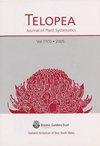苏柏科三体亚族属属概念的修正及一新属和一新种
IF 0.5
4区 生物学
Q4 PLANT SCIENCES
引用次数: 9
摘要
Tricostularia Nees ex Lehm。对该属群进行了审查,并正式认定为苏柏科部落Schoeneae亚部落Tricostulariinae R.L.Barrett, K.L.Wilson和J.J.Bruhl。来自质体rbcL和trnL-F以及核ITS和ETS区域的分子数据与形态学特征的新评估相结合,以支持我们的新分类。包括六个属:一个新属,Ammothryon R.L.Barrett, K.L.Wilson和J.J.Bruhl,以及已命名的Chaetospora R.Br。Morelotia Gaudich。, Tetraria P.Beauv。、Tricostularia和Xyroschoenus Larridon。Ammothryon, Chaetospora和Tricostularia都是澳大利亚南部的特有种。Morelotia在夏威夷、法属波利尼西亚和新西兰各有一种,在西澳大利亚西南部有三种。在非洲南部、婆罗洲、新几内亚和新喀里多尼亚有不间断的分布。Xyroschoenus是塞舌尔特有的。四分藻c.b.c clarke(基于四分藻octandra (Nees) c.b.c clarke)被包括在Morelotia的扩展概念下,该概念还包括来自西澳大利亚西南部的澳大利亚四分藻c.b.c clarke和microcarpa s.t.b blake四分藻。bennettiana Tricostularia R.L.Barrett & K.L.Wilson、davisii Tricostularia R.L.Barrett & K.L.Wilson、lepschii Tricostularia R.L.Barrett & K.L.Wilson、newbeyi Tricostularia R.L.Barrett & K.L.Wilson和sandifordiana Tricostularia R.L.Barrett & K.L.Wilson被描述为西澳大利亚西南部的新种。制备了以下新组合:洋桔梗(Nees ex Lehm)r.l.巴雷特,k.l.威尔逊和j.j.b bruhl,澳大利亚莫罗蒂亚(c.b.c clarke) r.l.b雷特和k.l.w wilson,小carpa莫罗蒂亚(s.t.b blake) r.l.b雷特和k.l.w wilson,八爪莫罗蒂亚(Nees) r.l.b雷特和j.j.b bruhl和drummondii Tricostularia (Steud)。r.l.巴雷特& k.l.威尔逊。drummondii Tricostularia drummondii是由其同义词(原Discopodium drummondii Steud.)恢复的,之前曾与t.e exsul (c.b.k clarke) K.L.Wilson和r.l.b reter混淆。选择了弯曲毛孢、薄壁毛孢、鼓形毛孢。;大桔梗;;;;;;,鳞翅目植物,C.B.Clarke, Morelotia gahniiformis Gaudich。minor未成年人;C.B.Clarke,细毛Tetraria var.intercedens k本文章由计算机程序翻译,如有差异,请以英文原文为准。
Revision of generic concepts in Schoeneae subtribe Tricostulariinae (Cyperaceae) with a new genus Ammothryon and new species of Tricostularia
The Tricostularia Nees ex Lehm. group of genera is reviewed and formally recognised as Cyperaceae tribe Schoeneae subtribe Tricostulariinae R.L.Barrett, K.L.Wilson & J.J.Bruhl. Molecular data from plastid rbcL and trnL–F and nuclear ITS and ETS regions are combined with a novel assessment of morphological characters to support our new classification. Six genera are included: a new genus, Ammothryon R.L.Barrett, K.L.Wilson & J.J.Bruhl, and the named genera Chaetospora R.Br., Morelotia Gaudich., Tetraria P.Beauv., Tricostularia, and Xyroschoenus Larridon. Ammothryon, Chaetospora and Tricostularia are all endemic to southern Australia. Morelotia has one species each in Hawaii, French Polynesia and New Zealand, and three species in southwest Western Australia. Tetraria has a disjunct distribution in Southern Africa, Borneo, New Guinea and New Caledonia. Xyroschoenus is endemic to the Seychelles. Tetrariopsis C.B.Clarke (based on Tetrariopsis octandra (Nees) C.B.Clarke) is included under an expanded concept of Morelotia, which also includes Tetraria australiensis C.B.Clarke and Tetraria microcarpa S.T.Blake from south-west Western Australia. Tricostularia bennettiana R.L.Barrett & K.L.Wilson, Tricostularia davisii R.L.Barrett & K.L.Wilson, Tricostularia lepschii R.L.Barrett & K.L.Wilson, Tricostularia newbeyi R.L.Barrett & K.L.Wilson, and Tricostularia sandifordiana R.L.Barrett & K.L.Wilson are described as new species from south-west Western Australia. The following new combinations are made: Ammothryon grandiflorum (Nees ex Lehm.) R.L.Barrett, K.L.Wilson & J.J.Bruhl, Morelotia australiensis (C.B.Clarke) R.L.Barrett & K.L.Wilson, Morelotia microcarpa (S.T.Blake) R.L.Barrett & K.L.Wilson, Morelotia octandra (Nees) R.L.Barrett & J.J.Bruhl and Tricostularia drummondii (Steud.) R.L.Barrett & K.L.Wilson. Tricostularia drummondii is reinstated from synonymy (formerly Discopodium drummondii Steud.), having previously been confused with T. exsul (C.B.Clarke) K.L.Wilson & R.L.Barrett. Lectotypes are selected for Chaetospora flexuosa var. gracilis Boeckeler, Discopodium drummondii Steud., Elynanthus grandiflorus Nees ex Lehm., Lampocarya affinis Brongn., Lepidosperma exsul C.B.Clarke, Morelotia gahniiformis Gaudich. var. minor A.Rich., Tetraria australiensis C.B.Clarke, Tetraria capillacea var. intercedens Kük., Tricostularia compressa Nees ex Lehm. and Tricostularia neesii Lehm.
求助全文
通过发布文献求助,成功后即可免费获取论文全文。
去求助
来源期刊

Telopea
PLANT SCIENCES-
CiteScore
1.30
自引率
42.90%
发文量
0
期刊介绍:
Manuscripts submitted for publication in TELOPEA are published online, after peer review and acceptance by the TELOPEA Editorial Committee and when final editorial formatting has been completed. The journal specialises in plant systematics and phylogeny. The geographic scope of the journal encompasses Australia, Malesia, Melanesia, Micronesia, and Polynesia. The suitability of a work for the journal depends on the topic and the region of origin, generally the narrower the focus of the manuscript the closer to New South Wales must be its geographic focus.
As a general guide, we will consider:
1) revisionary treatments and other substantial bodies of work from any of the regions mentioned above.
2) new species from any Australian state.
3) new country records for Australia from any state.
4) new state records from New South Wales only.
However, we aim to support botanical research across the broader Australasian and Pacific region, and will consider submissions on their merit.
Generally we will not consider extraterritorial new country records, or single lectotypification papers unless they pertain to New South Wales taxa, or have significant bearing on the Australian flora.
 求助内容:
求助内容: 应助结果提醒方式:
应助结果提醒方式:


